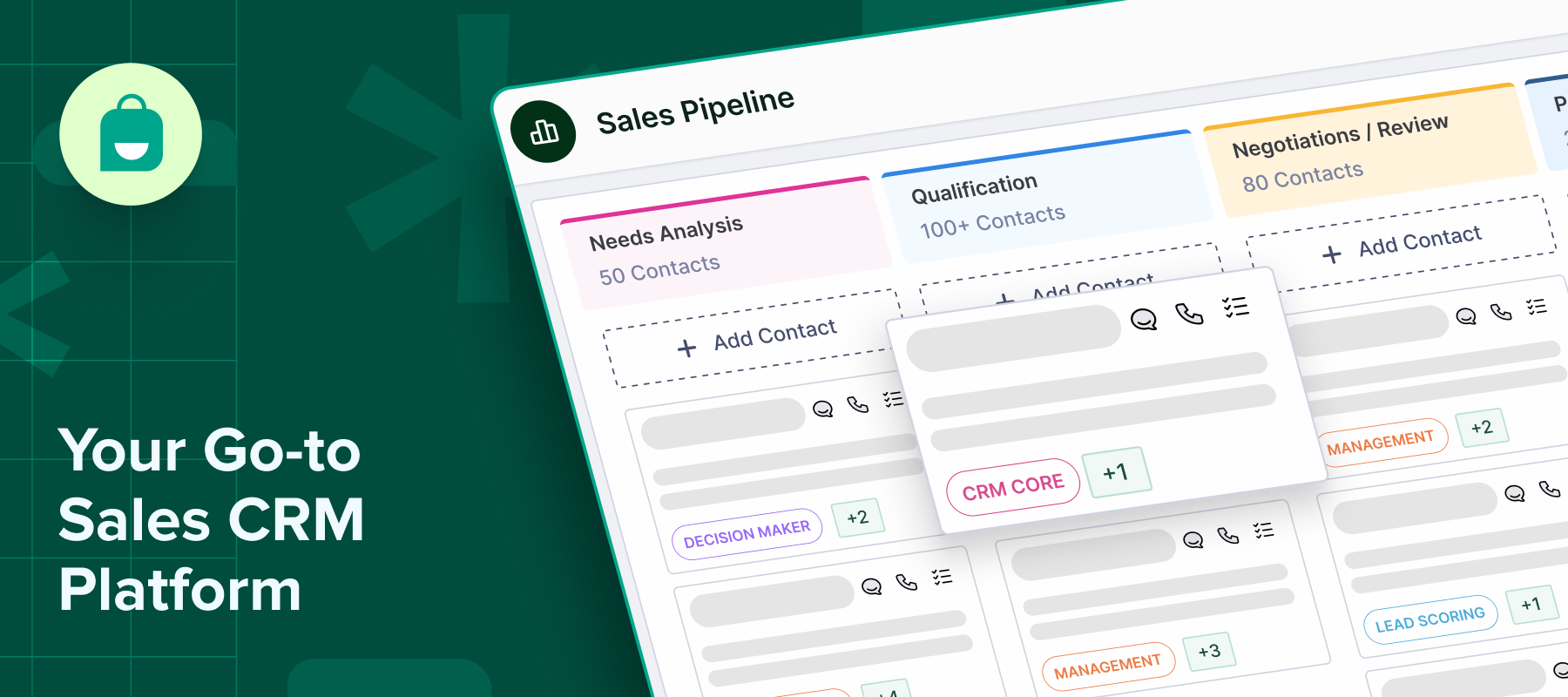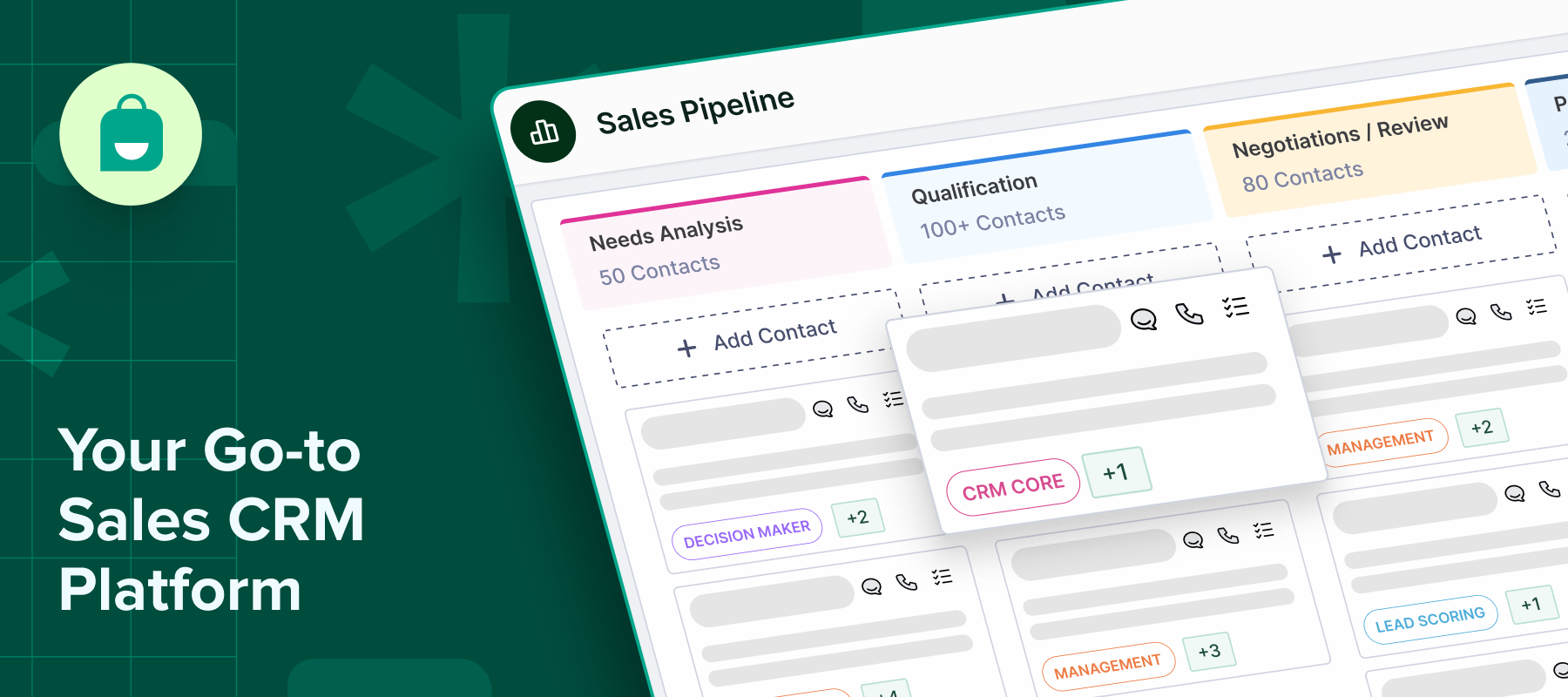Sales automation is the process by which businesses can automate repetitive and manual sales-related tasks like lead capture, follow-ups, pipeline updates, and reporting. This can free sales teams to focus on more strategic and critical functions like closing deals and building relationships, while reducing human errors and manual work, and improving overall sales efficiency.
In the fast-paced market that we are currently witnessing, sales automation becomes a necessity as it enables businesses to shorten sales cycles, scale faster, and stay consistent with the customer experiences they offer. However, to achieve truly effective automation, it’s no longer enough to rely on spreadsheets or disjointed tools.
Modern CRMs offer a perfect solution with built-in features that enable businesses to manage their pipeline, track interactions, and automate follow-ups seamlessly from a single central hub.
In this article, we will explore how to use Sales CRM tools for automating your sales process, with practical steps, tips, benefits, and best practices.
Understanding the sales process and CRM automation
To effectively automate your sales, you first need to understand how your sales process works and where CRM tools can make the biggest impact.
What is the sales process?
The sales process can be explained as a structured set of steps that a business follows in order to convert potential leads into paying customers. Typically, the sales process begins with lead generation, and then moves through qualification, engagement, and nurturing, and ends with the closing of the deal and post-sale follow-up.
How does CRM fit into this?
A CRM (Customer Relationship Management) system acts as the backbone of the sales process as it centralizes customer data, helps track interactions, and enables automated workflows.
A CRM tool can provide real-time visibility into where each prospective customer stands in the sales funnel and thus allows sales teams to manage relationships more strategically.
Different stages of the sales funnel and where CRM automation can assist
1.In the lead generation and qualification stage, CRM automation can help automatically collect leads from forms, chats, social channels, etc., and use scoring systems to identify high-value and high-potential prospects.
2.When it comes to lead nurturing, CRM sales automation can be used to set up automated follow-ups or email drip campaigns to keep prospects engaged.
3.Deal management can be simplified with sales automation, allowing you to move deals through pipeline stages automatically, based on actions such as replies or meeting bookings.
4.Tasks and reminders can be automated to ensure customers are informed and engaged at every stage of the sales funnel.
5.Feedback surveys and onboarding emails can be automatically triggered after a closed deal to ensure post-sale engagement and continued customer satisfaction.
Importance of automating repetitive tasks to improve productivity
It is important for productivity-focused businesses to automate routine, repetitive tasks as it can:
-Save time and reduce human error by eliminating the need for manual data entry and repetitive follow-ups.
-Ensure consistency in outreach with predefined workflows and templates, improving customer experience and team efficiency.
Step-by-step guide to automating your sales process using CRM
Follow these steps to streamline and automate your sales process using a CRM tool:
1. Select the right CRM for sales automation
Start by choosing a CRM tool that aligns with your budget, sales goals, and team size. Options like Interakt’s Sales CRM are built perfectly for modern businesses, offering automation capabilities, real-time tracking, and seamless integration with platforms like WhatsApp and Instagram.
2. Automate lead capture and nurturing
Set up your CRM to automatically collect leads from forms, chatbots, or social media. You can use workflows to trigger welcome messages or drip campaigns based on user activity and behaviour.
3. Automate follow-ups and reminders
The next step is to use automation to schedule follow-up emails, send reminders, or re-engage leads. This not only eliminates manual effort needed to keep prospects engaged, but also keeps your pipeline active and responsive.
4. Use CRM analytics for forecasting
Use CRM analytics for sales forecasting, performance tracking, and identifying drop-off points. This analytics data can be critical as it can enable you to take informed, data-driven decisions.
5. Integrate CRM with your sales stack
Your CRM should also connect with the tools that are already being used by your business. Interakt, for instance, supports ready integrations with popular eCommerce, marketing, and support platforms, thus bringing everything under one roof.
Benefits of automating your sales process with CRM
Below are some of the major CRM automation benefits that businesses can enjoy:
Increased efficiency and time savings
CRM sales automation reduces manual tasks like data entry, follow-ups, and scheduling, allowing your sales team to focus on more critical and high-impact activities like closing deals.
Better lead management and nurturing
Another benefit of CRM automation is that it helps capture, evaluate, and segment leads effortlessly. It ensures timely, personalized follow-ups that keep your prospects engaged throughout the funnel.
Higher conversion rates and sales productivity
With streamlined workflows and fewer missed opportunities, your sales team can quickly and seamlessly move leads through the pipeline, resulting in more conversions and improved performance.
Better customer experience and relationship management
The consistency of automated communication can help build trust, reliability, and brand credibility. CRM tools can also help your team to provide tailored conversations and thus strengthen long-term customer relationships.
Common challenges in automating sales with CRM and how to overcome them
While CRM automation offers tremendous benefits, implementing it isn’t without its hurdles.
Resistance to change and team adoption
It is likely that sales teams may hesitate to shift from manual methods to automation. Highlight how automation can support their goals while reducing workload and improving performance, to make for a seamless shift.
Ensuring data accuracy and system integration
Automation depends a lot on clean, consistent, accurate data. Ensure that your CRM integrates well with your existing tools and run regular audits to maintain consistency and avoid errors.
Training and optimizing CRM usage
CRM can only work its best when the team knows how to effectively use it. Offer hands-on training, encourage continuous learning, and share best practices to educate the team for optimal and effective CRM usage.
Top CRM tools for sales automation
Here are some of the best sales automation CRM tools out there that can be used for automating the sales pipeline:
Interakt
Interakt offers a comprehensive sales CRM solution designed with D2C and eCommerce brands of all sizes in mind. Interakt can help centralize customer conversations and automate workflows, and can integrate seamlessly with platforms like Shopify and WooCommerce.
Features:
-Automated responses and chat flows
-Shared team inbox for better collaboration
-AI-powered insights into customer behavior, sales trends, agent performance, etc.
-Real-time analytics and reporting
-Seamless integration with payment gateways, eCommerce platforms, marketing automation platforms, etc.
Pricing:
Interakt offers a free trial and has plans starting from $45 per month.
Zoho CRM
Zoho CRM is a versatile sales CRM option that caters to businesses of all sizes. Zoho offers a comprehensive suite of tools for not just sales, but also marketing and customer support.
Features:
-Sales automation and workflow management.
-Lead and deal management
-Sales process builder
-Real-time reporting and analytics
-Omnichannel support
Pricing:
Zoho CRM has a free plan as well as paid plans starting at $14 per user per month.
HubSpot CRM
HubSpot CRM is a popular choice for many businesses, ranging from startups to enterprises, mainly due to its user-friendly interface and robust features.
Features:
-Contact and deal management
-Marketing automation and lead nurturing
-Integration with over 1000 apps.
-Sales pipeline visualization.
Pricing:
HubSpot has a free plan with basic CRM features, and paid plans with advanced features starting from $20 per month.
Freshdesk CRM
Part of the Freshworks suite, the Freshworks CRM focuses on customer support and engagement, offering a range of features to help with ticket management.
Features:
-Omnichannel support
-Automated workflows and SLA management
-Customizable reports and dashboards
-Integration with various third-party tools and platforms.
Pricing:
Freshdesk CRM is free with basic features for up to 10 agents, and offers paid plans starting at $15 per agent per month.
Pipedrive
Pipedrive is a great sales-focused CRM that emphasizes pipeline management and sales automation. It is a great choice for small to mid-sized businesses.
Features:
-Email integration and tracking
-Sales reporting and forecasting
-Visual sales pipeline and deal tracking
-Customizable fields and workflows
Pricing:
Pipedrive has plans starting from $14 per user per month.
Must-have CRM Features
Here are some features you need to look for in a sales CRM:
Lead scoring and segmentation
The tool should enable more targeted outreach by quickly identifying high-potential leads and grouping them based on behavior, source, or intent.
Automated workflow builder
The CRM tool should allow you to set up custom workflows to automate tasks like assigning leads, triggering emails, or moving deals through pipeline stages.
Email and communication automation
Look for tools with personalized email and communication automation. Additionally, templates and scheduling features can help you keep your communication consistent and thus, effective.
Sales pipeline management
Having an intuitive and visual pipeline is also crucial as it allows you to track where every deal stands, monitor bottlenecks, and thus make informed decisions quickly as needed.
Task and activity reminders
Automated alerts for calls, meetings, and follow-ups is another crucial feature as they can help sales teams to stay on top of every opportunity. It keeps all the team members aligned and ensures no customer is left hanging.
Integration with marketing and support tools
Ensure your CRM connects easily with email platforms, channels like WhatsApp, support tools, and more. Interakt, for example, offers ready integrations with diverse tools and platforms to unify your sales and customer touchpoints.
AI-powered forecasting and insights
Advanced CRMs come with built-in analytics and AI that can accurately predict sales outcomes, highlight deal health, and recommend next-best actions, helping you and the team stay proactive.
Mobile CRM access
For businesses with remote or field teams, it is important that the sales CRM offers mobile access to leads, pipelines, and communication tools.
Customizable dashboards and reports
Tailored dashboards are also an important feature that can help your team visualize performance, track progress, and make more informed decisions.
CRM API and third-party integrations
Look for sales automation CRMs with flexible integration options that allow you to connect with other tools and extend your CRM’s functionality as your business grows.
How to measure the success of sales automation
You can track the following indicators and metrics to measure the performance of automation:
Conversion rates
Monitor how many leads are being converted into customers after the implementation of sales automation. Higher conversion rates indicate that the leads are nurtured and moved seamlessly through the sales funnel.
Time saved
You should also evaluate the amount of manual work reduced, as CRM automation’s success can be understood by looking at how effectively it cuts down on the time spent on repetitive tasks.
ROI
Calculate returns by comparing the cost of your CRM tool and automation setup against the revenue generated through improved efficiency and higher conversions.
Interakt’s CRM comes with built-in analytics and reporting tools that can help track these key metrics in real-time, giving you a clear view of what’s working for your business.
Remember, sales automation isn’t a one-time fix. Make continuous improvement a core part of your strategy by regularly reviewing data, optimizing your workflows, and aligning automation with the evolving needs of the customer.
Conclusion
Sales automation should be viewed as growth-essential rather than a luxury, enabling businesses of all scales to automate manual tasks and streamline their sales funnels. But it is also important to understand that the key lies in choosing a CRM that aligns with your business goals and scales with your growth.


